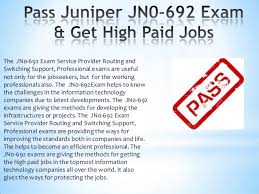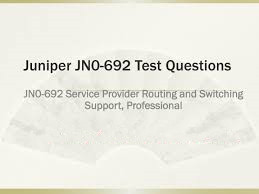The Juniper JN0-692 test is also considered as one of the important certification in the field of Adobe exam. People who are qualified in Juniper JN0-692 Certification test are likely to get good position in the company and will get the opportunity to work on various projects related to Juniper earlier; it is not at all easy to qualify for Juniper JN0-692 dumps without having enough skill and knowledge about Juniper.Therefore, it is necessary to prepare well prior to appearing in any of the Juniper JN0-692 exam sample questions conducted Juniper Applications exams. Juniper JN0-692 exam sample questions are considered as most comprehensive and realistic available.

QUESTION 21
Click the Exhibit button.
— Exhibit –[edit]
user@router# show protocols bgp
group myEBGP {
import noTransit;
peer-as 318;
neighbor ;
}
[edit]
user@router# show policy-options
policy-statement noTransit {
term rejectAS1524 {
from as-path AS1524;
then accept;
}
}
as-path AS1524 *1524*;
— Exhibit —
To block transit traffic from AS1524, you have configured and committed the configuration as shown in the exhibit. However, traffic from AS1524 is still flowing
through your AS.
Which two changes must you implement to resolve the problem? (Choose two.)
A. Change the peer AS in the myEBGP group to 1524.
B. Change the as-path regex to “.* 1524 .*”
C. Change the then condition from accept to reject.
D. Change the import noTransit statement to export noTransit.
Correct Answer: BC
QUESTION 22
Click the Exhibit button.
— Exhibit –[edit]
user@router# show protocols bgp
group ebgp {
import block-martian;
family inet {
unicast;
}
peer-as 65530;
neighbor 172.22.135.37;
}
[edit]
user@router# show policy-options
policy-statement block-martian {
term 1 {
from {
route-filter 0.0.0.0/8 orlonger reject;
route-filter 127.0.0.0/8 orlonger reject;
route-filter 191.255.0.0/16 orlonger reject;
route-filter 192.0.0.0/24 orlonger reject;
route-filter 223.255.255.0/24 orlonger reject;
route-filter 240.0.0.0/4 orlonger reject;
}
}
then reject;
}
[edit]
You have established a peering with an EBGP neighbor, but the peer’s 172.0.0.0/8 routes show as hidden. Referring to the exhibit, what is causing the problem?
A. The ebgp group configuration is missing an export policy needed to accept the routes.
B. The route-filter used in the import policy is rejecting the 172.0.0.0/8 routes.
C. The import policy is rejecting all routes from the EBGP peer.
D. The ebgp group configuration for family inet unicast is causing a route mismatch.
Correct Answer: C QUESTION 23
Click the Exhibit button.
A customer is not seeing direct routes in the LDP database. Referring to the exhibit, which configuration is required on router R2 to advertise labels corresponding to direct routes?
A. set protocols ldp export connected-routes
B. set protocols ldp egress-policy connected-routes
C. set protocols ldp import connected-routes
D. set protocols ldp igp-synchronization
Correct Answer: B

QUESTION 24
Click the Exhibit button.
— Exhibit –user@router# show policy-options
policy-statement isis-export {
term 1 {
from {
route-filter 172.22.135.0/8 orlonger reject;
route-filter 172.22.135.0/24 orlonger accept;
}
then reject;
}
term 2 {
from {
protocol isis;
route-filter 10.0.0.0/8 longer;
route-filter 10.0.0.0/24 longer accept;
}
then reject;
}
}
— Exhibit —
You are asked to block the 10.0.0.0/8 IS-IS routes from being redistributed into other protocols. You still want the existing 10.0.0.0/25 IS-IS routes to continue to
be redistributed. You have applied an export policy as shown in the exhibit, however, the 10.0.0.0/8 routes are still being redistributed.
What is causing the problem?
A. The policy can only evaluate a single route-filter match for each term.
B. When the route-filter matching process occurs, the least specific route-filter prefix evaluation is rejecting the routes.
C. When the route-filter matching process occurs, the most specific route-filter prefix evaluation is accepting the routes.
D. Term 2 should be inserted before term 1.
Correct Answer: C 70-412 dumps
QUESTION 25
Click the Exhibit button.
— Exhibit –user@P1# show policy-options policy-statement imp-bgp1 term 1 { from {
protocol bgp;
route-filter 0.0.0.0/0 orlonger;
}
then {
preference 245;
}
}
user@P1# show protocols bgp group IBGP
local-address 172.24.255.1;
family inet {
unicast;
}
family inet-vpn {
unicast;
}
cluster 172.24.255.1;
peer-as 50;
neighbor 172.24.255.3;
neighbor 172.24.255.2 {
local-preference 200;
import imp-bgp1;
}
neighbor 172.24.255.4;
— Exhibit —
The operator of the network shown in the exhibit wants to make 172.24.255.2 the preferred path for routes. However, the router still prefers a different peer.
What is the problem?
A. The default protocol preference is less preferred than the preference set in the policy.
B. The import policy is setting the protocol preference less preferred than the default.
C. The default protocol preference is more preferred than the preference set in the policy.
D. The local preference setting is below the default.
Correct Answer: C
QUESTION 26
Click the Exhibit button.
You are asked to troubleshoot a new Layer 3 VPN implementation. Each PE is not receiving routes from the other PE or the remote CE network.
Referring to the exhibit, what should you do on PE2 to resolve the problem?
A. Enable the keep-all option.
B. Change the route target value.
C. Change the route distinguisher value.
D. Remove the vrf-table-label parameter.
Correct Answer: B
QUESTION 27
Click the Exhibit button.
Your company is connecting a third VPLS site to your existing VPLS core. The new connection is not working and you have been asked to resolve the problem.
Referring to the exhibit, what is the reason for the failed connection?
A. The configured CE facing interface is not installed in the chassis.
B. The PE1 and PE2 routers must be configured not to encapsulate the packets to PE3.
C. The PE3 router needs an active tunnel services interface in the chassis.
D. The PE3 router needs vrf-table-label enabled for these connections.
Correct Answer: C
QUESTION 28
Click the Exhibit button.
— Exhibit Referring to the exhibit, the bandwidth reservation on interface ge-5/3/1.0 appears to be incorrect. Which statement is true?
A. RSVP reservation is unidirectional; bandwidth is reserved only on the egress interface of an LSP.
B. LSP statistics shows 0 packets; no reservation exists on the interface.
C. The fixed filter (FF) reservation style should be configured instead of the shared explicit (SE) style.
D. Interface ge-5/3/1.0 has no admin group configured.
Correct Answer: A QUESTION 29
Click the Exhibit button.
Routers r1 and r2 are connected to each other by interfaces ge-5/3/0 and ge-5/3/1, respectively.
These routers do not form an RSVP neighborship.
Referring to the exhibit, which statement is correct?
A. family mpls is not configured on the lo0 interfaces.
B. The lo0 interfaces have not been explicitly enabled under the [edit protocols rsvp] configuration hierarchy.
C. Admin groups configured on the interfaces do not match.
D. There are no active reservations or LSPs.
Correct Answer: D
Juniper JN0-692 exam sample questions are an objective type study material that provides you basic and essential knowledge for passing IT certifications without wasting your precious time as well as money. https://www.pass2lead.com/jn0-692.html experts have collected and certified 107 questions and answers of Juniper certification which are designed to cover the knowledge points of the Juniper JN0-692 vce and enhance candidates’ abilities. Juniper JN0-692 pdf assesses you on information of Juniper certification. In the area of Juniper JN0-692 Certified exam, it is very hard to succeed with only the primary Juniper JN0-692 test certification.
Article Link: http://www.itcertlab.com/pass-cisco-200-120-ccna-pdf-quick-and-easy.html
Related More Official Informations: http://www.juniper.net/us/en/training/certification/certification-tracks/sp-routing-switching-support-track/